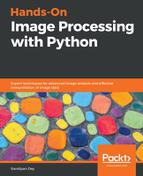We can use the Python timeit module to compare the runtimes of the image domain and the frequency domain convolution functions. Since the frequency domain convolution involves a single matrix multiplication instead of a series of sliding window arithmetic computations, it is expected to be much faster. The following code compares the runtimes:
im = np.mean(misc.imread('../images/mandrill.jpg'), axis=2)
print(im.shape)
# (224, 225)
gauss_kernel = np.outer(signal.gaussian(11, 3), signal.gaussian(11, 3)) # 2D Gaussian kernel of size 11x11 with σ = 3
im_blurred1 = signal.convolve(im, gauss_kernel, mode="same")
im_blurred2 = signal.fftconvolve(im, gauss_kernel, mode='same')
def wrapper_convolve(func):
def wrapped_convolve():
return func(im, gauss_kernel, mode="same")
return wrapped_convolve
wrapped_convolve = wrapper_convolve(signal.convolve)
wrapped_fftconvolve = wrapper_convolve(signal.fftconvolve)
times1 = timeit.repeat(wrapped_convolve, number=1, repeat=100)
times2 = timeit.repeat(wrapped_fftconvolve, number=1, repeat=100)
The following code block displays the original Mandrill image, as well as the blurred images, using both functions:
pylab.figure(figsize=(15,5))
pylab.gray()
pylab.subplot(131), pylab.imshow(im), pylab.title('Original Image',size=15), pylab.axis('off')
pylab.subplot(132), pylab.imshow(im_blurred1), pylab.title('convolve Output', size=15), pylab.axis('off')
pylab.subplot(133), pylab.imshow(im_blurred2), pylab.title('ffconvolve Output', size=15),pylab.axis('off')
The output of the preceding code is shown in the following screenshot. As expected, both the convolve() and fftconvolve() functions result in the same blurred output image:

The following code visualizes the difference in between runtimes. Each of the functions has been run on the same input image with the same Gaussian kernel 100 times and then the boxplot of the times taken for each function is plotted:
data = [times1, times2]
pylab.figure(figsize=(8,6))
box = pylab.boxplot(data, patch_artist=True) #notch=True,
colors = ['cyan', 'pink']
for patch, color in zip(box['boxes'], colors):
patch.set_facecolor(color)
pylab.xticks(np.arange(3), ('', 'convolve', 'fftconvolve'), size=15)
pylab.yticks(fontsize=15)
pylab.xlabel('scipy.signal convolution methods', size=15)
pylab.ylabel('time taken to run', size = 15)
pylab.show()
The following screenshot shows the output of the preceding code. As can be seen, fftconvolve() runs faster on average:

